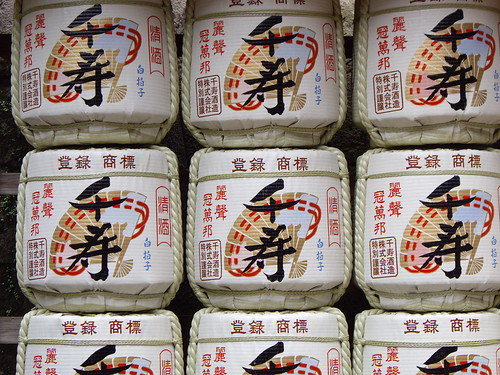
I left at 7:15 Gojo guesthouse where I took 2 different lines (keihan & Kintetsu ) and after 50 min
I arrived at
So be in advance at the station and the message is: plan your trip very well before arriving at the station.
My plan for the day is to visit some temples, walk through the city and be back at 17:30 at Uzumasa station in
Before leaving the station I just popped in the toursit office where I took some plans.
The employee starts to talk to me and asks me if I want to have a guide? I never heard about these kind of guides, but I accepted this as a nice opportuniy to have some assistance and so I started my walk with Ms.Yukiko Furukawa in
These guide organisation started after the EXPO in
We walked 5 hours together with the sun in our back. Hereafter I will tell you about some places she guided me in
In the entrance of temples and also here for example, believers have a book that they give to the monk at the entrance of the temple. He will make a calligraphy and put a stamp with the symbol of the temple in it. With this new calligraphy people will continue to find harmony in their lives.
In
The deer are sacred animals and are a symbol in
We continued in the direction of the Todaiji temple (built in 743).
From a distance you can see 2 horns on the top of the roof of this temple, but finally Yukiko told me that they are 2 golden fishes. These fishes protect the temple from fire. They are a part of the sea. This place was dammaged several times (2 times the great Buddha hall burned in the fires
of war in 1180 and 1567), but anyway it’s magic. I have a lot of admiration for
the fact that after the fire they built it again and they did that also for many other places again to preserve this cultural heritage like the Castle in
The time when Todaiji¹ was built was at when Buddhism was at its height, and served as a state religion. When we went inside we could see its Daibutsu, a colossal statue that, with 15 meters in height, is the world's largest gilded bronze Buddha. It is housed in an all-wood building, the Daibutsu-den, 48 meters in height. Even if the place is now ± 33% smaller than that of the original structure it still ranks as the largest wooden structure in the world.
The Southern entrance (Nandai mon) is also very impressive; Pass this entrance and you will be surrounded at left and right of the 2 wonderfully expressive guardians gods (Nio) They are more than 7m toll each. One of the big differences is that you have one with the sword in his hand (ready to attack) and the other one has his sword still in his saya. 2 lions are outside on both side also guardians of this place. From any entrances it’s still very impressive to see the temple. It’s so big!!
Before leaving the temple I received a small bottle (3 cm) with the bouddha inside as gift from my guide. This as a gift to be able to compare this one with the one I will see later in
Which one will be the most beautifull in your eyes??
¹the text with the dimensions of the Todaiji temple are coming from the website himself and folder.



